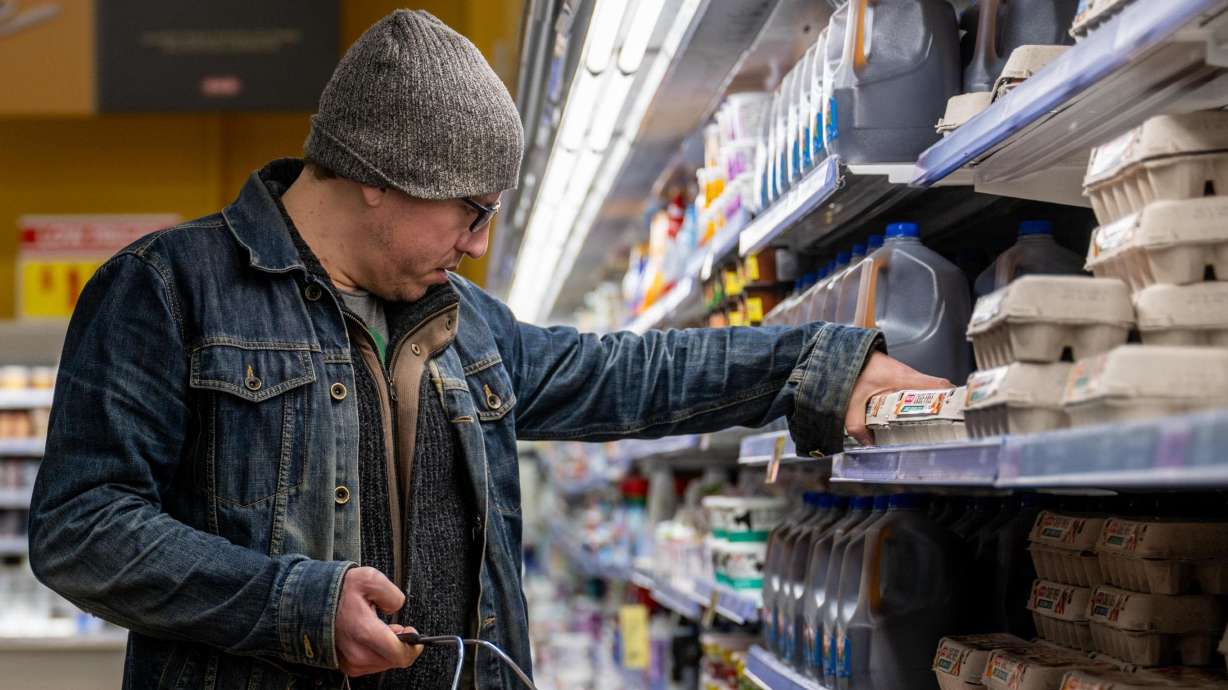Estimated read time: 4-5 minutes
This archived news story is available only for your personal, non-commercial use. Information in the story may be outdated or superseded by additional information. Reading or replaying the story in its archived form does not constitute a republication of the story.
EAGAN, Minn. — The winter holidays typically make for busier times at The Open Door Pantry food shelf in the Twin Cities suburb.
On the Monday before Christmas the day's food appointments were full. Nearly 100 volunteers quickly and methodically sifted through thousands of pounds of freshly donated food.
The daily appointments are booked solid through the end of January, and demand has been overwhelming for The Open Door's other community-based food distribution events.
While 2023 was the year that meaningful progress was made on slowing down painfully high inflation, 33 months' worth of fast-rising prices took their toll on many Americans, especially those with lower incomes.
To that point, this year also marks a record year for food pantry visits in Minnesota and beyond — in many cases, by a country mile.
"The years of inflation, they stacked on top of each other," said Jason Viana, The Open Door's executive director. "We were seeing the impact of (rising wages), but inflation wiped all that out."
Turning the corner?
In 2022, the U.S. saw inflation spike to levels not seen in four decades, and the Federal Reserve was in the throes of a historic rate-hiking campaign to cool it back down.
At the start of this year, inflation had moderated some — the Consumer Price Index had cooled to 6.5% in January 2023 from its 9.1% peak in June 2022. However, the U.S. economic outlook was clouded by ongoing fears that the aggressive Fed campaign would lead to a downturn.
Those dire predictions did not materialize.
The labor market remains strong, which has helped to fuel consumer spending and keep the broader economic engine churning. The housing refinancing boom of previous years and the resurgent stock market have made many — but certainly not all — households wealthier.
"It's been a difficult few years, but I do think that in 2023, the situation is improving for households as inflation has slowed and as wage growth has remained above the pre-pandemic trend," said Gus Faucher, senior vice president and chief economist of the PNC Financial Services Group.
Soaring fuel costs, surging food prices
Although the speed of price hikes has gotten better, that's not to say it's been pleasant by any means.
"Consumers remember a couple of years ago when they could buy something for quite a bit less," said Kayla Bruun, senior economist with market research and analytics company Morning Consult. "Food prices are a very visible (piece) and something you're buying very frequently, and there's a lot of awareness of what those prices are, maybe second only to gas prices."
More than 90% of the items tracked in the Consumer Price Index are more expensive than they were in February 2020, with most price increases landing north of 20% and some (fuel and margarine) approaching 55%, Bureau of Labor Statistics data shows.
Food prices are nearly 25% higher.
"Even as your inflation rates slow, prices are still well above where they were ahead of the pandemic," said Shannon Seery, an economist with Wells Fargo. "Households are still grappling with that. Obviously, a slowing price growth environment is beneficial, but when you have the price growth we've had over the past few years, it kind of compounds on itself."
That layering effect of inflation compounded with decades-high interest rates as well as the expiration of pandemic emergency measures further squeezed household's budgets and forced many to rely on food donations, Merissa Piazza, a senior policy analyst for the Federal Reserve Bank of Cleveland, wrote in a November blog post.
"Low-income households are particularly vulnerable to these increases because they spend a greater share of their income on food," she wrote.
'Absolute hope' for relief
"I've been barely getting by, by the skin of my teeth, for the last three years since COVID," said DiNoto, 50, who said she is a disabled veteran on a fixed income. "With the cost of food, the cost of everything going up, I'm getting to the point where I have zero money left over at the end of the month."
DiNoto said she has racked up credit card debt to cover unexpected expenses.
"This month, I could not pay any of my bills," she said. "And my debts and my bills are mounting, and now I've got late payments hitting me and all these credit card fees, and now my minimum payments have gone up, and I'm hurting bad."
Inflation is expected to let up further through 2024, a year that could see some relief as well on the interest rate front.
Such a combination could give Americans more breathing room and hopefully be enough to bring those who are struggling the most back from the brink, said The Open Door's Viana.
"If inflation can stay down, and wages can continue to grow, there is absolute hope that families will be able to get back on their feet and require less support," he said.









